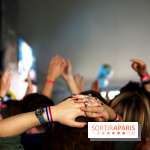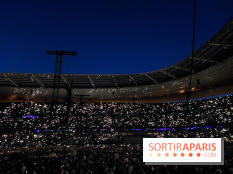The mere mention of its name takes us back in time, and reminds us of the extent to which the Fête de l'Humanité has been able to stand the test of time, establishing itself over the years as France's biggest annual popular event .
Every September, for three days, this musical and festive event opens its doors to thousands of festival-goers, eager to come and listen to the artists programmed for the occasion. The Pink Floyd, Joan Baez, The Who, Chuck Berry, Léo Ferré, Ray Charles, Johnny Hallyday, Nina Hagen, Noir Désir, La Mano Negra, Carlos Santana and Patti Smith are just some of the countless artists who have already had the honor of gracing one of the stages at the Fête de l'Humanité. But there's much more to the event than concerts. Far from it. The Fête de l'Huma is a multicultural event where exhibitions, cinema, circus and theater also have their place. And, of course, the Fête de l'Humanité is also and above all characterized by its militancy, marked by numerous debates.
As the Fête de l'Humanité leaves its historic site in Seine-Saint-Denis in 2022 to move to Essonne, we invite you to delve into the history and origins of this unmissable musical and popular festival.
It all began when Marcel Cachin, director of the newspaper l'Humanité from 1918 to 1958, devised an event to support the Communist daily. The Fête de l'Humanité was held for the very first time on September 7, 1930, in the Parc Sacco et Vanzetti, in Bezons (Val-d'Oise).
At the time, this popular festival was an opportunity to make repeated calls for workers' unity and the Popular Front. The event featured a number of stalls, lotteries, theater and brass bands, as well as sports such as basketball and the famous sack races.
Shows soon took on greater importance. In 1935, for example, the Fête de l'Huma hosted Jacques Prévert's musical " Vive la presse ". In 1937, the festival opened its doors to the French Cancan and singer-actress Marianne Oswald. A year later, Charles Trenet took part. While the Fête de l'Humanité was the first in France to introduce microphones for shows in 1935, the event organized its first major concerts in 1936 during the Popular Front. The event proved a great success, with attendance topping the 300,000 mark that year.
After an enforced pause between 1939 and 1944 due to the outbreak of the Second World War, the Fête de l'Humanité affirmed the need to rebuild France, and attendance hit a new record with a million people gathered in 1945 in the Bois de Vincennes.
Then, with the advent of the Cold War, the Fête de l'Humanité was placed under the aegis of peace. Among other things, the popular event denounced the crimes of French imperialism. The growing number of wars in the world between 1950 and 1975 also prompted the Fête de l'Humanité to take sides, notably against the Indochina War and the Vietnam War.
It was also during this period that restaurants were set up on the event site. By 1951, there were over 300 stands. What else was new? The vignette-bon de soutien au journal l'Humanité was created in 1952, while several major exhibitions were held in 1966, featuring works by Picasso and Fernand Léger.
Then, in the early 1970s, the famous debates between communists, socialists and left-wing radicals were held on the stands.
Alongside this, the Fête de l'Huma continues its major campaigns, such as the release of Angela Davis and Nelson Mandela, or the support for Ireland in the presence of Bobby Sands' brother in 1981. The event also opened up to more surprising worlds, such as fashion. In 1988, the festival hosted the Yves Saint-Laurent fashion show on the Grande Scène!
1999 marked a turning point, as l'Humanité was no longer the central organ of the PCF. From then on, the Fête de l'Huma set out to establish itself as a major event for social movement players to meet and exchange ideas. In the 2000s, the Fête de l'Humanité became a huge gathering of the social and political left. NGOs, associations, trade unions and other political forces are all welcome, and the Fête de l'Huma now sees itself as a place where social struggles and international solidarity converge.
Since its creation in 1930, the Fête de l'Humanité has regularly changed venue: Bezons, Bois de Vincennes, Montreuil, Meudon, not forgetting of course La Courneuve; its historic site. The move to Essonne in 2022 marks a new turning point in the history of this festival, which is determined to remain France's biggest popular event!
Fête de l'Huma 2024: complete program and concert times
The Fête de l'Humanité is back! The event, organized each year by the newspaper L'Humanité, takes place on Friday 13th, Saturday 14th and Sunday 15th September 2024 at the former air base 217 at Plessis-Pâté, in the heart of Essonne! On the program? Louise Attaque, Calogero, rapper SCH, artists Jain and Santa, producer Vladimir Cauchemar, the talented Angélique Kidjo, not forgetting rapper MC Solaar, Kalash Criminel, Sandra Nkaké, Pomme and Tiken Jah Fakoly! Following the cancellation of Louane and Calema, Shaka Ponk and Les Vulves Assassines join the line-up. Click here for the full program and concert times! [Read more]
Fête de l'Huma 2024: programming, access, opening hours... here's everything you need to know
The Fête de l'Huma returns to Base 217 on Friday September 13, Saturday September 14 and Sunday September 15, 2024. For this third consecutive edition in Essonne, some fifty artists are expected on site over three days. Program, opening times, access to Base 217, history of France's biggest popular event... here's everything you need to know before coming to the Fête de l'Humanité 2024. [Read more]
Official website
fete.humanite.fr







 Fête de l'Huma 2024: complete program and concert times
Fête de l'Huma 2024: complete program and concert times


 Fête de l'Huma 2024: programming, access, opening hours... here's everything you need to know
Fête de l'Huma 2024: programming, access, opening hours... here's everything you need to know














